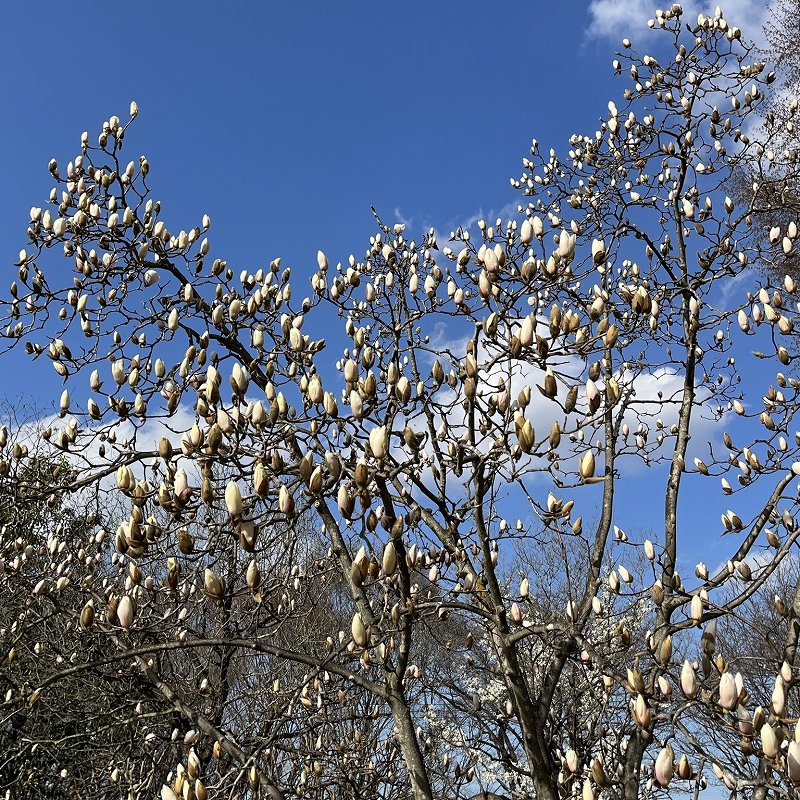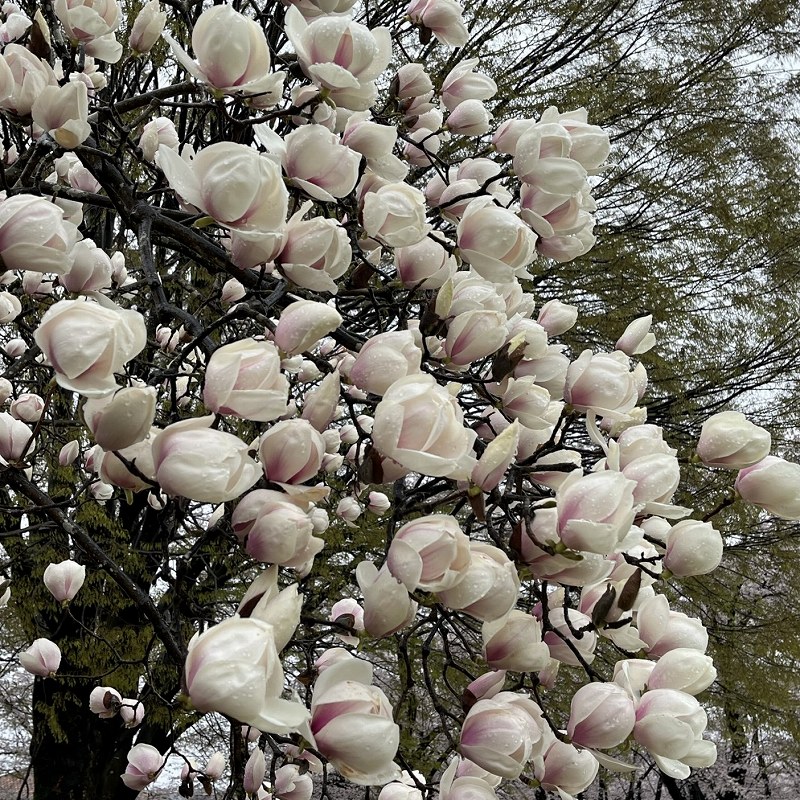サラサモクレンは「木蓮」と「白木蓮」を掛け合わせて作られました。名前の由来は、紅さす白花が木綿の模様染め「更紗」を思わせるから。
Saucer Magnolia was made by crossing “Magnolia liliiflora” and “Magnolia denudata”. Japanese name of it means that white flowers with red make you think of sarasa pattern dyeing on cotton.
【仮名】サラサモクレン, ニシキモクレン
【和名】更紗木蓮, 錦木蓮
【英名】Saucer Magnolia
【学名】Magnolia x soulangeana
【誕生】03/ ??
【開花】03, 04月
【花色】Pink






サラサモクレン
サラサモクレンの来歴
サラサモクレンはモクレン科の落葉小高木です。1820年にフランスの植物学者エティエンヌ・ソランジュ・ボダンが「木蓮」と「白木蓮」の種間交雑で育成。花が美しく、暑さにも寒さにも耐えることから世界中に広がりました。多くの品種が育成される一方、中国では自然交雑種も。
サラサモクレンの名前
サラサモクレンの名前の由来は、紅さす白花が木綿の模様染め「更紗」を思わせるから。美しい織物に喩えて「錦木蓮」とも呼ばれます。ラテン語の属名マグノリアはフランスの植物学者ピエール・マニョル、種小名ソランゲアナは育成者エティエンヌ・ソランジュ・ボダンへの献名。
サラサモクレンの姿形
サラサモクレンは丈が高くなりつつ、横にも広がります。樹皮は白灰色で滑らか、葉は先が尖った倒卵形で互生。花は白木蓮の後、木蓮の前に咲きます。花被片は外側の下のほうが薄紅色で9枚。ほぼ白色からほぼ紅色まで幅があります。花後の袋果は熟すと割れ、朱色の種子が露出。
サラサモクレンの白色
サラサモクレンの白色はモクレン科の落葉高木「白木蓮」に由来。「白蓮」とも呼ばれ、春なかばの葉が伸びる前、芳香のある花を上向きに半開させます。種小名デヌダータは「裸の」という意味で、袋果が熟すと割れて中の種子が露出。花言葉は「荘厳」「崇高」「慈悲」などです。
サラサモクレンの紅色
サラサモクレンの紅色はモクレン科の落葉低木「木蓮」に由来します。花が赤紫色なので別名「紫木蓮」とも。古代中国では宮廷の庭園に植えられ、日本へは古くに薬用で渡来しました。種小名リリフローラは「ユリのような花の」という意味。花言葉は「自然への愛」「恩恵」です。
Saucer Magnolia
History of Saucer Magnolia
Saucer Magnolia is a deciduous small tree of the Magnoliaceae family. It was created in 1820 by French botanist Etienne Soulange-Bodin bred this plant by crossbreeding “Magnolia liliiflora” and “Magnolia denudata”. It spread all over the world because the flowers are beautiful and endure both heat and cold. While many varieties are bred, there are also natural hybrids in China.
Name of Saucer Magnolia
Japanese name of it means that white flowers with red make you think of sarasa pattern dyeing on cotton. It looks like a beautiful fabric, so it is also called “Nishiki magnolia”. The Latin genus name Magnolia is a dedication to French botanist Pierre Magnoll, and the specific name Soulangeana is a dedication to the breeder Etienne Soulange-Bodin.
Shape of Saucer Magnolia
Saucer Magnolia grows taller and spreads out sideways. The bark is whitish gray and smooth, and the leaves are obovate with pointed tips and alternate. The flowers bloom after Magnolia denudata and before Magnolia liliiflora. The outer lower part of the perianth is light red and has 9 pieces. It ranges from almost white to almost red. After flowering, the pouched fruit splits when ripe, exposing the vermilion seeds.
White of Saucer Magnolia
The white color of Saucer Magnolia comes from the deciduous tall tree of the Magnoliaceae family “Magnolia denudata”. The fragrant flowers are half-opened upward before the leaves grow in mid-spring. The specific epithet Denudata means “naked”, because when the pods ripen, they split open to expose the seeds inside. The language of flowers is “solemn”, “sublime”, and “mercy”.
Red of Saucer Magnolia
The red color of Saucer Magnolia comes from the deciduous shrub of the Magnoliaceae family “Magnolia liliiflora”. In ancient China, it was planted in the gardens of the imperial court, and was brought to Japan for medicinal purposes in ancient times. The specific epithet Liliiflora means “lily-like flower”. The language of flowers is “love for nature” and “benefit”.


